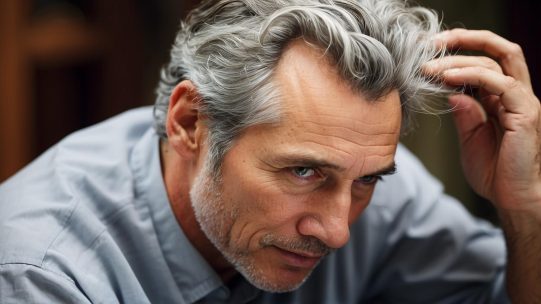Discovery of Hair Regrowth May Make Baldness “Optional”

The best way to prevent baldness is to prevent hair loss. Now researchers say a new discovery about hair growth may help men keep their hair for life.
The new discovery is a structure inside the hair follicle.
‘Our main discovery is a previously unknown smooth muscle called the dermal sheath that surrounds the hair follicle,’ explains lead researcher Dr. Michael Rendle. He is the Associate Director of the Black Family Stem Cell Institute at the Icahn School of Medicine at Mount Sinai in New York City.
Dr. Rendle explains that during the life cycle of a human hair, new hair shafts are created by papilla cells. These specialized cells originate at the base of a growing hair follicle and slowly move upward to stem cells at the tip of the follicle.
These stem cells receive signals from nearby papilla cells and “trigger the next phase of growth, creating new hair shafts while the previous ones fall out,” the researchers explain in a Mount Sinai press release.
Sometimes, however, this intercellular interaction can become disrupted. This may be the cause of hair loss.”
One question that has long puzzled researchers is how hair papilla cells migrate to stem cells.
In experiments with mice, “we found the answer to this mechanism when we discovered that the dermal sheath surrounding the growing hair follicle is smooth muscle and that its function is to contract, push the hair shaft up and pull the dermal papilla up,” says Rendle.
According to Prof. Rendl, further experiments show that the human hair works by a similar mechanism.
Then, during the “breakdown” phase of the hair growth cycle, the dermal sheath shrinks and existing hair bundles fall out.
This phenomenon occurs naturally when there is a lot of hair on the head, but if it occurs too often, baldness develops.
According to Dr. Lendl, the new understanding of dermal sheath function could change the direction of hair loss research.
Blocking newly discovered muscles and their contractions will not help cure baldness caused by these processes. On the contrary, blocking the contraction and decay phases of the cycle may preserve existing hair shafts that are lost when new ones appear.
Muscles of this type cannot be controlled voluntarily. But they can be controlled with drugs that block contractions.
In other words, maybe one day men will be able to be treated to simply maintain their existing hair rather than gradually losing their head of hair.
‘I’m excited about the possibility of developing a way to block sheath contraction, stop follicle regression and prevent existing hair loss before new hair starts to grow,’ says Rendle.”
One dermatologist who specializes in baldness said the discovery could offer new hope for men with hair follicle disorders.
The future of thinning hair is very promising, and this study shows that baldness may soon be an option,” said Dr. Michelle Green of Lenox Hill Hospital in New York City.
There have been many studies on hair restoration, but this study shows that the dermal sheath can preserve hair follicles and restore new hair growth.”
Green believes that modifying the dermal sheath can not only stop the hair growth cycle before the “destruction” stage, but also “prevent the hair follicle from going into a dormant state.”
Dormant hair follicles cannot grow hair because they cannot be regrown.”
That’s because “a dormant hair follicle cannot be regenerated, so it cannot grow hair.”
There is still a long way to go before it will be possible to stop the hair growth cycle in its destructive phase by inhibiting the contraction of the sheath muscles. First, it must be proven that the effect will be achieved on human hair follicles. Then, after we know what happens to the stopped hair follicle in the long term, we need to prove its safety.” ”
Nevertheless, we are excited to explore this question,” Lendl said.
The study was published in the journal Science on Dec. 19.










Comment